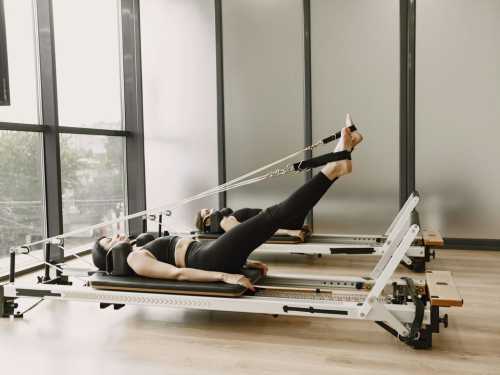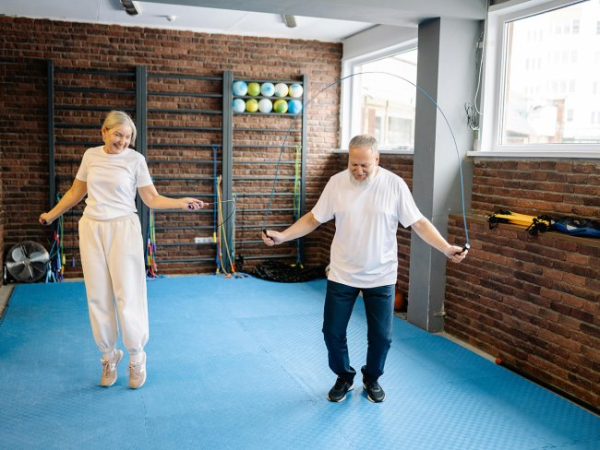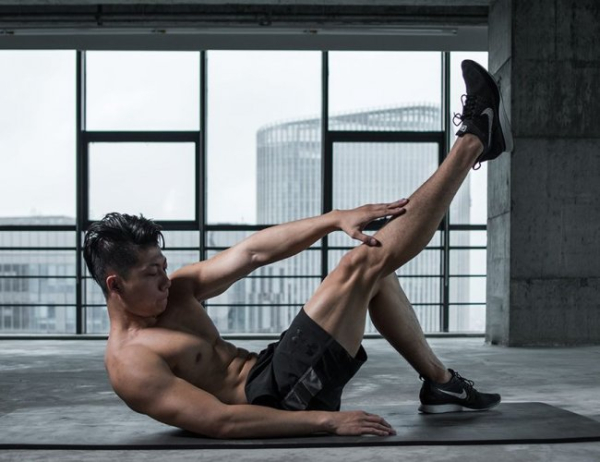
The number of fitness clubs and online training platforms is growing rapidly, and their owners are looking for new ways to attract and retain customers with the help of interesting and unusual formats. One of these areas is Pilates on the reformer. Let's figure out why this area is so popular, who it can suit, and whether it can be replaced with more budget-friendly training.
A reformer is a special exercise machine that resembles a bed with a moving platform, springs, and straps. It allows you to perform exercises with additional resistance and support.
Reformer Pilates services are now offered by many studios in major cities, and their number is increasing. In the West, this trend is even more noticeable.
It's no wonder that reformer Pilates is so popular among stars: its fans include Jennifer Aniston, Adele, Naomi Campbell, Meghan Markle, Cristiano Ronaldo, and Justin Bieber.
How hospital beds turned into exercise machines
The exercise system known today as Pilates was developed by German Joseph Hubertus Pilates in the 1920s. Drawing on his experience in gymnastics, acrobatics, martial arts, and working with the wounded, he created the Contrology method—training aimed at developing strength, flexibility, and conscious control over the body.
The first prototypes of the machines appeared in hospitals, where Pilates used ordinary hospital beds: he attached springs and straps to them to vary the resistance and adapt the load to the specific needs of the patients. Thus were born the designs that became the basis of modern reformers.
In the 1940s, Pilates began working with ballet dancers and adapted the technique for floor exercises, creating mat Pilates, which made the exercises accessible to a wider audience and helped them gain popularity.
What is the secret of the reformer's popularity today?
How did an exercise system created to rehabilitate wounded soldiers and restore injured ballerinas become one of the most fashionable trends with millions of followers?
There may be several reasons: some people like the individual and technological approach to training, while others like the visual aesthetics inherent in Reform Pilates.
Classes are gaining popularity primarily because many stars, actors, and athletes choose Pilates on the reformer, they perform beautiful, aesthetic, and unusual exercises, and this attracts attention. You can perform exercises in different poses, each has a lot of variations and combinations, you definitely won't get bored during such training. The unstable platform requires attention and concentration, which allows you to disconnect from problems, clear your head, and establish contact with your body.
What are the benefits of Pilates on the reformer?
Pilates can be practiced both to maintain fitness and to address specific health issues. In most cases, Pilates is combined on the reformer and on mats. For example, the warm-up and cool-down are on the mat, and the main part is on the reformer.
Here are just a few advantages of this method:
Pilates on the reformer adapts to any level of fitness
It gives beginners the opportunity to adjust the resistance and load.
This method develops strength, endurance, coordination, balance and flexibility. Unlike many exercise programs that isolate one muscle group, Pilates forces the body to work as a whole.
All muscle groups are developed comprehensively, including deep stabilizer muscles, and joint and spine mobility improves. For the figure, the plus is that the core muscles are strengthened, and this is the basis for our posture and a beautiful figure. The muscles become not only strong, but also elastic. This improves the overall tone of the body, and better blood circulation and overall well-being are also positively reflected in the appearance.
Pilates on the reformer is suitable for those who want relief, but are afraid to pump up. It does not aim for hypertrophy (growth of muscle volume), but instead forms tight, toned muscles. Due to improved posture and flexibility, the body visually looks slimmer and “elongated” – this is the very effect that everyone strives for.
These qualities make reformer Pilates a great option for those who have no experience with regular training.
Pilates on the reformer is also great for professional athletes: it allows you to develop individual muscle groups.
It is also suitable for people recovering from injuries, as well as those who experience chronic back pain.
Classes allow you to strengthen the muscular corset, increase flexibility and range of motion without injuring problem areas.
Indications for classes are pain syndrome without neurological disorders in the thoracic and cervical spine, scapula, stiffness and discomfort in these areas. Also pain in the lower back and sacrum, deep gluteal pain. Classes can be extremely useful for uncomplicated hernias and protrusions, as they help prevent exacerbations. However, in such cases, training is possible only after consultation with a doctor and under the supervision of a qualified rehabilitation specialist.
Pilates on the reformer is good for addressing pelvic floor problems in women and may be a suitable option for pregnant women.
This type of training is also suitable for those looking for effective low-impact training without axial load. This is important, for example, for osteoporosis or joint problems.
What are the disadvantages? Reformer training is more expensive than regular classes
This is logical: studios have to purchase expensive equipment, which also requires quite a lot of space. Sometimes it is necessary to invest in additional training of trainers. Plus, fashion and high demand affect the price.
For example, the cost of one group Pilates class is often 2-3 times cheaper than a group reformer class.
Classes require a competent trainer with appropriate training.
The trainer should have deeper knowledge in the field of anatomy and biomechanics. Then, in conjunction with the doctor, he can provide quick and lasting results, for example, when it comes to recovery after operations or injuries, including sports injuries.
Classes are held only in the studio.
It is theoretically possible to buy a simulator for home use, but due to its size and cost, this is rather rare.
When choosing a studio, remember that the point of classes is to work out your body in a focused manner in a calm environment under the close supervision of a trainer. In pursuit of profit, some gyms try to fit in as many exercise machines as possible, which sometimes means that people have to work out in cramped conditions and noise due to increased demand. In such conditions, the trainer cannot pay enough attention to each client, hence the risks of incorrect execution. This leads to ineffective classes at best, and injuries at worst. Hence the next minus.
Improper technique can cause injuries, especially for beginners.
There are no statistical data on the risk of injury from Pilates on the reformer, there is only information about individual cases of fractures and less significant injuries.
There are certain safety rules when working on the reformer. Since the carriage is moving, there is a risk of losing balance and getting injured. To avoid this, you need to work with a trainer and listen carefully to his commands.
Possible complications include increased pain syndrome due to incorrectly selected load or injuries due to improper use of equipment.
With adequate initial testing in the hands of a competent trainer, the likelihood of injury during the session is minimal. This is a load that can be carefully dosed and the pace of progression can be chosen. All elements are fixed, the trainer is always nearby.
What are the restrictions and prohibitions for training on the reformer?
If you have pain syndrome, you can start Pilates classes on the reformer only after consulting with an orthopedic traumatologist or neurologist.
Those who have recently undergone surgery or suffered a serious injury, such as a fracture, dislocation or torn tendon, should not rush into a regular fitness group. In such cases, full rehabilitation under the supervision of a specialist is required. It is worth noting that adapted Pilates is often an important part of this recovery process, but it should be carried out under the guidance of a rehabilitation instructor or physical therapist, not a regular trainer.
During pregnancy, you can only do Pilates with the approval of your gynecologist. If your pregnancy is complicated, you should not do it at all.
Another limitation is the child's age: Pilates on the reformer is not recommended until the child is 8-9 years old, while the child cannot fully understand what is required of him during the exercise. From about 9 years old, such training is possible – for example, to treat scoliosis.
Can I replace Pilates on the reformer with something else?
Pilates' success today is largely due not only to its effectiveness, but also to its popularity among celebrities. It's important to remember that stars who show off unrealistically beautiful bodies, supposedly sculpted on reformers, often owe their results not only to training, but also to plastic surgery and weight loss drugs.
Marketing aside, the key principle remains simple: Your muscles don't care how you create the load—with reformer springs, dumbbells, a rubber band, or your own weight. Only three factors matter: effort, gradual increase in load, and regularity. They are what lead to changes in the body.
The reformer is really convenient: it helps to better control movements, reduces the load on the joints and allows you to vary the exercises. But if you want, you can easily replace it with other means: exercise machines in the fitness room or exercises on the mat. For a home complex, a minimum of equipment is enough – a roller, a fitball and an elastic band.
If you don't have any medical restrictions, it doesn't matter whether you work out in an expensive club with a trainer or at home with a set program. It's important to find a format that suits you and helps you maintain interest in your workouts.
Джерело: ukr.media






